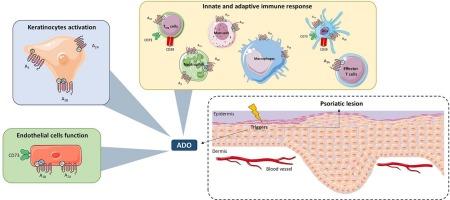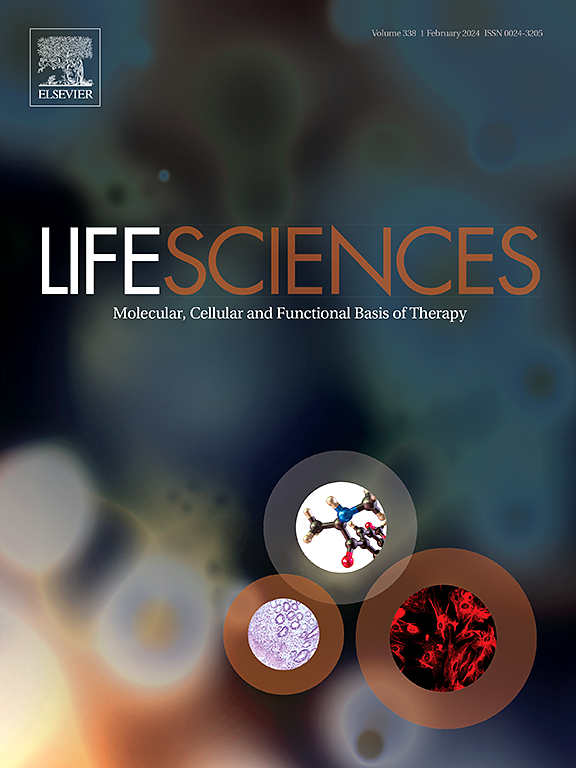Insight into adenosine pathway in psoriasis: Elucidating its role and the potential therapeutical applications
IF 5.2
2区 医学
Q1 MEDICINE, RESEARCH & EXPERIMENTAL
引用次数: 0
Abstract
Psoriasis is an inflammatory skin disease, that can manifest as different phenotypes, however its most common form is psoriasis vulgaris (plaque psoriasis), characterized by abnormal keratinocyte proliferation, leading to characteristic histopathological signs of acanthosis, hyperkeratosis and parakeratosis.
For many years, there has been a debate regarding whether keratinocyte dysfunction leads to immune system dysregulation in psoriasis or vice versa. It is now understood that epidermal hyperplasia results from immune system activation. Besides epidermal hyperplasia, psoriatic skin shows leukocyte infiltration, evident angiogenesis in the papillary dermis, characterized by tortuous, dilated capillaries, as well as oedema.
There is substantial early evidence that adenosine is a key mediator of the immune response; it derives from ATP hydrolysis and accumulates into tissue in response to systemic and local stress conditions, hypoxia, metabolic stress, inflammation. Adenosine controls several cell functions by signalling through its 4 receptor subtypes, A1, A2A, A2B and A3. Evidence suggests that adenosine may play a role in psoriasis pathogenesis by controlling several immune cell functions, keratinocyte proliferation, neo-angiogenesis. Expression of adenosine receptor varies in psoriatic skin, and this can significantly impact on tissue homeostasis. Indeed, an altered adenosine receptor profile may contribute to the dysregulation observed in psoriasis, affecting immune responses and inflammatory pathways.
Here, we discuss the role of adenosine in regulating the functions of the main cell populations implied in the pathogenesis of psoriasis. Furthermore, we give evidence for adenosine signalling pathway as target for therapeutic intervention in psoriasis.

洞察银屑病中的腺苷通路:阐明其作用和潜在的治疗应用。
银屑病是一种炎症性皮肤病,可表现为不同的类型,但最常见的类型是寻常型银屑病(斑块状银屑病),其特点是角质细胞异常增殖,导致特征性的组织病理学表现,如棘皮、过度角化和角化不全。多年来,人们一直在争论,到底是角质细胞功能障碍导致了银屑病的免疫系统失调,还是免疫系统失调导致了角质细胞功能障碍。现在人们已经明白,表皮增生是免疫系统激活的结果。除表皮增生外,银屑病皮肤还表现出白细胞浸润、真皮乳头层明显的血管生成(其特点是毛细血管迂曲、扩张)以及水肿。早期有大量证据表明,腺苷是免疫反应的关键介质;腺苷来源于 ATP 水解,并在全身和局部应激条件、缺氧、代谢应激、炎症等情况下积聚到组织中。腺苷通过其 4 种受体亚型(A1、A2A、A2B 和 A3)发出信号,从而控制多种细胞功能。有证据表明,腺苷可能通过控制多种免疫细胞功能、角质形成细胞增殖和新血管生成,在银屑病发病机制中发挥作用。腺苷受体在银屑病皮肤中的表达各不相同,这会对组织的平衡产生重大影响。事实上,腺苷受体谱的改变可能会导致银屑病中观察到的失调,影响免疫反应和炎症途径。在此,我们将讨论腺苷在调节银屑病发病机制中主要细胞群功能方面的作用。此外,我们还提出了将腺苷信号通路作为银屑病治疗干预靶点的证据。
本文章由计算机程序翻译,如有差异,请以英文原文为准。
求助全文
约1分钟内获得全文
求助全文
来源期刊

Life sciences
医学-药学
CiteScore
12.20
自引率
1.60%
发文量
841
审稿时长
6 months
期刊介绍:
Life Sciences is an international journal publishing articles that emphasize the molecular, cellular, and functional basis of therapy. The journal emphasizes the understanding of mechanism that is relevant to all aspects of human disease and translation to patients. All articles are rigorously reviewed.
The Journal favors publication of full-length papers where modern scientific technologies are used to explain molecular, cellular and physiological mechanisms. Articles that merely report observations are rarely accepted. Recommendations from the Declaration of Helsinki or NIH guidelines for care and use of laboratory animals must be adhered to. Articles should be written at a level accessible to readers who are non-specialists in the topic of the article themselves, but who are interested in the research. The Journal welcomes reviews on topics of wide interest to investigators in the life sciences. We particularly encourage submission of brief, focused reviews containing high-quality artwork and require the use of mechanistic summary diagrams.
 求助内容:
求助内容: 应助结果提醒方式:
应助结果提醒方式:


